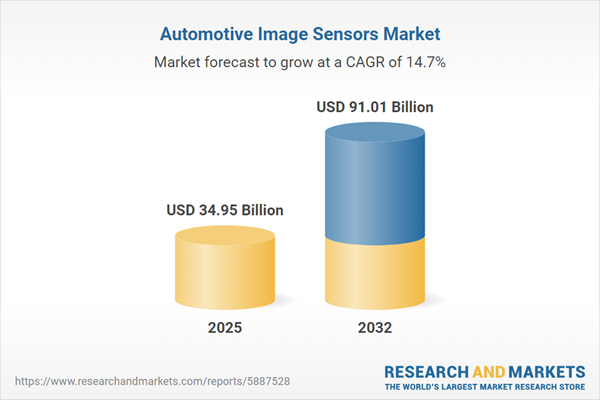Speak directly to the analyst to clarify any post sales queries you may have.
As the automotive industry accelerates the integration of advanced driver assistance and autonomous features, automotive image sensors have become essential for enhancing vehicle safety, intelligence, and performance. Stakeholders across the value chain are collaborating to ensure sensors meet the challenges posed by evolving regulatory, technical, and consumer demands.
Automotive Image Sensors Market Snapshot
The automotive image sensors market grew from USD 30.43 billion in 2024 to USD 34.95 billion in 2025. Driven by a robust CAGR of 14.67%, it is forecast to reach USD 91.01 billion by 2032, reflecting substantial expansion and rising adoption rates. This growth is influenced by stricter safety regulations, increased electrification of fleet, and a surge in consumer appetite for advanced camera-enabled features. Market expansion is strongly tied to innovations in sensor chip architecture and the rapid development of artificial intelligence, positioning image sensors at the forefront of next-generation automotive technologies.
Scope & Segmentation of the Automotive Image Sensors Market
- Sensor Chip Type: CCD, CMOS
- Installation: Aftermarket, OEM
- Application: Adaptive Cruise Control, Collision Warning, Lane Departure Warning, Traffic Sign Recognition, Infotainment Camera, Interior Monitoring System, Night Vision Camera, Rear View Camera, Bird's Eye View and Panoramic Surround View
- Vehicle Type: Commercial Vehicle, Passenger Car, Two-Wheeler
- Mounting Position: Front View, Interior View, Rear View, Side View
- Resolution: 2 to 5 MP, 5 to 10 MP, Greater Than 10 MP, Less Than or Equal to 2 MP
- Pixel Size: 2 to 2.5 Micron, Greater Than 2.5 Micron, Less Than 2 Micron
- Interface Type: Analog Video Interface, Digital Video Interface, LVDS, MIPI CSI-2
- Region: Americas (including North America, Latin America), Europe, Middle East & Africa, Asia-Pacific
- Key Companies: Sony Semiconductor Solutions Corporation, ON Semiconductor Corporation, OmniVision Technologies Inc., Samsung Electronics Co., Ltd., STMicroelectronics N.V., Infineon Technologies AG, ams AG, Panasonic Corporation, GalaxyCore Inc., SmartSens Technology Co., Ltd.
Key Takeaways for Senior Decision-Makers
- Market growth is propelled by the integration of AI-powered visual perception, enabling vehicles to interpret complex driving environments and deliver advanced assistance functions.
- OEM and aftermarket sensor solutions are diverging in their technical requirements, with OEM installations prioritizing system longevity and qualification, while aftermarket focuses on versatility and ease of integration.
- Regulatory mandates are a catalyst for sensor adoption, with evolving global and regional safety standards driving investments in sensor fusion and system validation.
- Partnerships between chipmakers, software architects, and integrators are shaping technology roadmaps and promoting the rapid commercialization of new sensor modules.
- Regional discrepancies in adoption are influencing product design, manufacturing strategies, and supply chain configuration, making market localization a critical success factor.
Impact of 2025 United States Tariffs on Supply Chains and Pricing
New US tariffs on semiconductor and electronic components introduced in 2025 have increased complexities for automotive OEMs and Tier 1 suppliers. These trade measures led to rising input costs and triggered a shift in sourcing toward tariff-exempt regions and enhanced nearshoring. Cost pass-through negotiations with automakers are increasingly challenging, as stakeholders seek to balance supply continuity, procurement flexibility, and overall margin structure. The market is now characterized by greater scenario planning and the strengthening of regional supply arrangements to align with evolving trade and policy landscapes.
Methodology & Data Sources
This report is grounded in a multi-source methodology that blends in-depth interviews with senior executives in industry-leading organizations and extensive secondary analysis of technical literature, regulatory filings, and company disclosures. The data has been validated through triangulation, with expert panels stress-testing assumptions and market segmentation, ensuring robust and actionable insights.
Why This Report Matters
- Supports confident strategic planning by presenting a holistic view of global and regional trends impacting the automotive image sensors market.
- Equips senior leaders with actionable intelligence on segment growth levers, regulatory dynamics, and partnership opportunities to guide investment or procurement decisions.
- Enables rapid alignment with evolving technology standards and resilient supply chain practices to maintain competitive relevance.
Conclusion
The automotive image sensors market is reshaping mobility by fusing vision technology, regulatory compliance, and ecosystem collaboration. Stakeholders that proactively adapt to shifting demands will be well-positioned to unlock sustained value as market dynamics evolve.
Additional Product Information:
- Purchase of this report includes 1 year online access with quarterly updates.
- This report can be updated on request. Please contact our Customer Experience team using the Ask a Question widget on our website.
Table of Contents
3. Executive Summary
4. Market Overview
7. Cumulative Impact of Artificial Intelligence 2025
Companies Mentioned
The companies profiled in this Automotive Image Sensors market report include:- Sony Semiconductor Solutions Corporation
- ON Semiconductor Corporation
- OmniVision Technologies, Inc.
- Samsung Electronics Co., Ltd.
- STMicroelectronics N.V.
- Infineon Technologies AG
- ams AG
- Panasonic Corporation
- GalaxyCore Inc.
- SmartSens Technology Co., Ltd.
Table Information
| Report Attribute | Details |
|---|---|
| No. of Pages | 190 |
| Published | October 2025 |
| Forecast Period | 2025 - 2032 |
| Estimated Market Value ( USD | $ 34.95 Billion |
| Forecasted Market Value ( USD | $ 91.01 Billion |
| Compound Annual Growth Rate | 14.6% |
| Regions Covered | Global |
| No. of Companies Mentioned | 11 |









